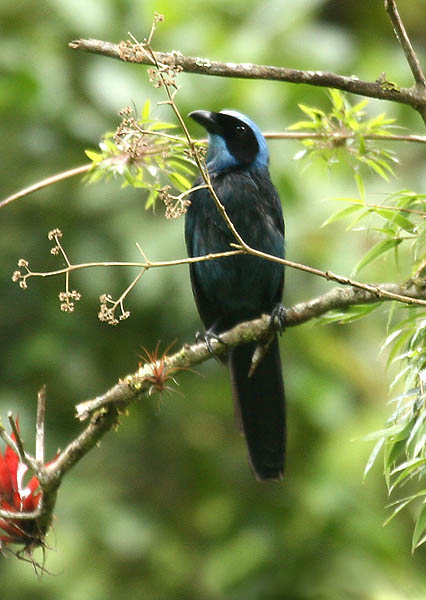
The world of avian species is incredibly vast and varied, yet few families capture the imagination quite like the Corvidae, a group renowned for its intelligence and often, its striking aesthetics. Within this illustrious family, jays stand out as perhaps the most boisterous and visually arresting members, often heralded as among the smartest creatures in the bird kingdom. Across North America alone, a diverse array of these captivating birds thrives, each boasting a unique blend of plumage, behavior, and ecological significance.
This comprehensive guide is dedicated to unveiling the distinct profiles of North America’s most remarkable jay species. Much like curating a collection of high-end design, we delve into the intricate details that define these birds, from their vibrant markings and impressive vocalizations to their intriguing habits and preferred habitats. We aim to offer an exclusive glimpse into the lives of these often-misunderstood yet undeniably fascinating residents of our shared natural landscapes.
Prepare to journey through a meticulously cataloged showcase of these intelligent corvids. Each species presents its own narrative of adaptation, survival, and sometimes, playful antics, painting a vivid picture of the rich biodiversity found within the continent’s woodlands and beyond. Join us as we explore the essential characteristics that make each North American jay an icon in its own right, celebrating their individual flair and collective grandeur.
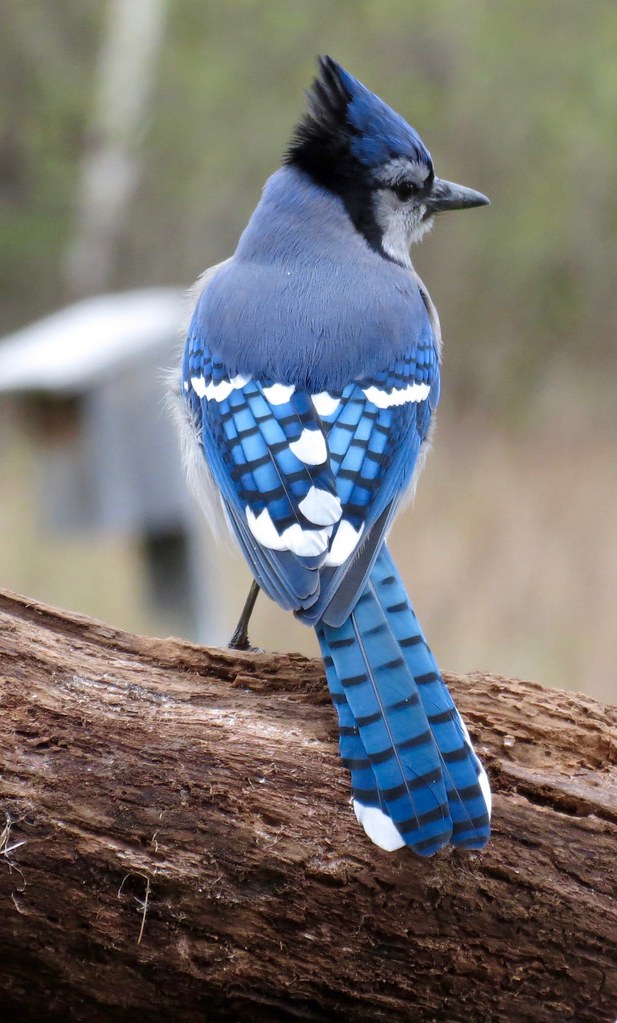
1. **Blue Jay**Perhaps the most immediately recognizable of its North American kin, the Blue Jay, scientifically known as *Cyanocitta cristata*, is a common large songbird that commands attention with its vibrant display. Its signature features include a distinctive blue upright crest, a back adorned with shades of blue and black, and a crisp white underside. Adding to its unmistakable charm are the telltale white wing-bars and a narrow black neckline, ensuring this bird is hard to miss in any setting.
These striking birds primarily inhabit the eastern US states and Southern Canada throughout the year, though some individuals may undertake infrequent migrations westward for winter. Blue Jays are adaptable residents, equally at home in dense forests, particularly near oak trees where acorns are abundant, and in the more accessible environments of suburban backyards. Their preference for oak woodlands underscores their reliance on acorns, a primary food source.
Beyond acorns, their omnivorous diet is quite varied, encompassing insects, various nuts and seeds, and grains. Intriguingly, Blue Jays have also been known to exhibit a more predatory side, occasionally taking eggs from other nests or even preying on nestlings. Their dietary flexibility allows them to thrive in diverse ecological niches, showcasing their opportunistic nature and intelligence in foraging.
Blue Jays communicate through a diverse repertoire of sounds, ranging from harsh clicks, peeps, ‘caws,’ and whistles, reflecting their noisy and social disposition. During courtship, however, they reveal a softer side, often emitting a gentle, fluted song that stands in contrast to their more common, assertive calls. This vocal versatility highlights the complexity of their social interactions, adding another layer to their already captivating presence.
For those eager to attract these magnificent birds, Blue Jays are not particularly shy about visiting feeders. They exhibit a preference for platform or tray feeders, which facilitate a quick arrival, grab, and exit, allowing them to carry away peanuts or sunflower seeds to consume elsewhere. Offering a combination of peanuts, sunflower seeds, and suet, along with a birdbath, can reliably transform your backyard into a favored destination for these crest-bearing beauties. They also display a playful side, with a known propensity to engage with shiny objects like aluminum or bottle caps, carrying them around and dropping them, a curious habit that adds to their charismatic appeal, making them truly unique.
Read more about: Beyond the Billionaire Bling: Deconstructing the ‘Bugatti Challenge’ TikTok Trend and Its Cultural Resonance
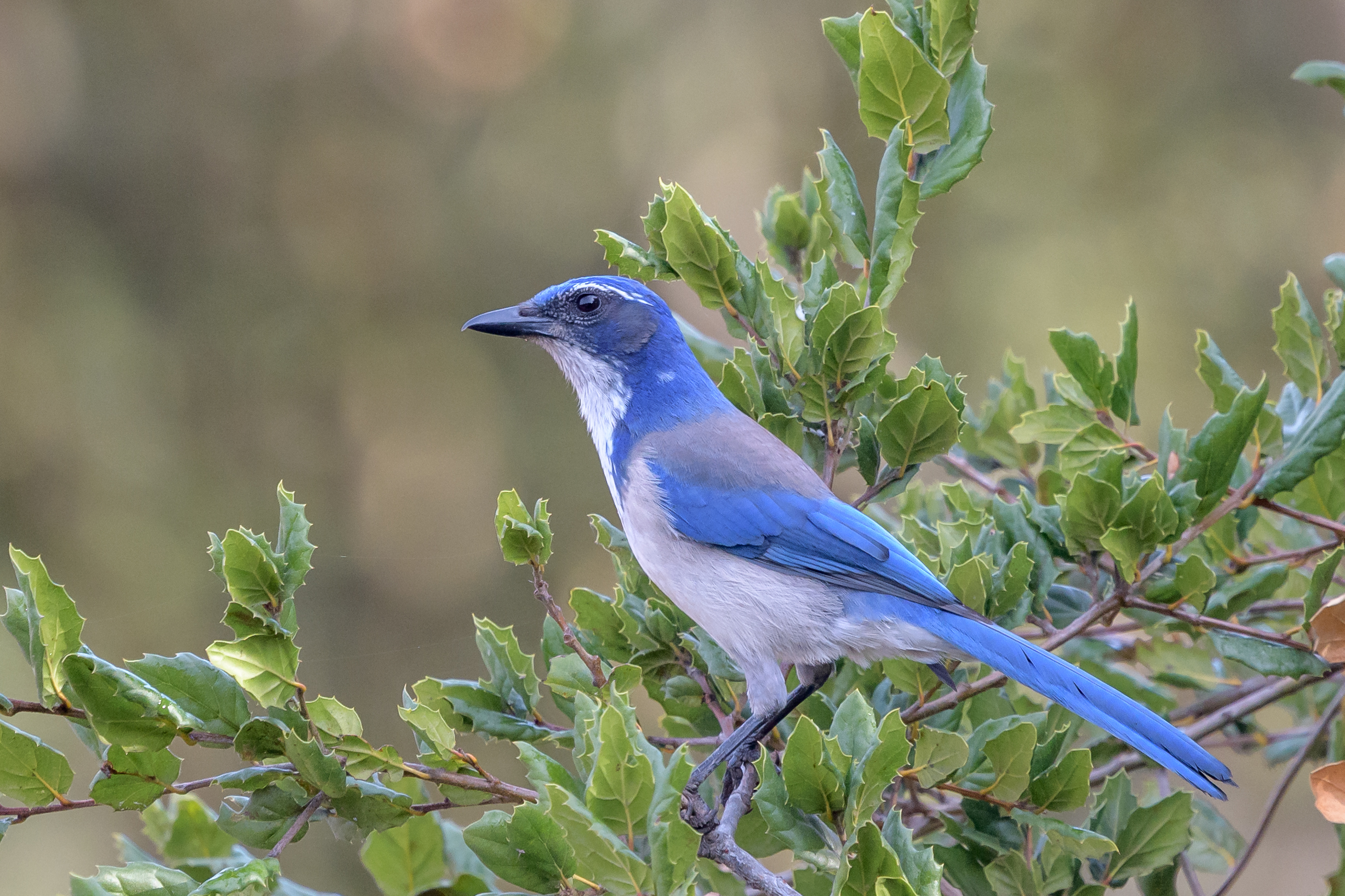
2. **California Scrub-Jay**The California Scrub-Jay, *Aphelocoma californica*, represents another cornerstone in North America’s avian tapestry, often seen flitting through coastal regions. These large songbirds are readily identified by their distinct physical attributes: long tails, whitish undersides, and rich blue and gray backs, accentuated by a bright blue breast band. While visually similar to their Woodhouse’s Scrub-Jay cousins, the California variety boasts more vivid colors, making them a standout in their habitats. Their size is notable, being larger than a robin yet smaller than a crow, granting them a robust presence in their environment.
Residents year-round on the Pacific Coast, their range stretches impressively from British Columbia down to Baja California. These crestless blue-and-gray jays are a common sight in shrubby areas, oak woodlands, and even within the developed landscapes of suburban yards and parks. Their adaptability to various terrains speaks to their resilience and ability to thrive alongside human expansion, much like an enduring cultural icon adapting to new trends.
As omnivores, their diet shifts seasonally, reflecting a sophisticated foraging strategy. During the spring and summer months, they primarily feast on insects and fruits, leveraging the abundance of fresh produce. Come fall and winter, their menu transitions to seeds and nuts, with a particular fondness for acorns, which they are known to ingeniously bury for later consumption, showcasing an impressive level of foresight and planning. This caching behavior is crucial for their survival during leaner periods.
Their vocal repertoire is equally distinctive, characterized by high-pitched and repetitive scolding cries, which serve as a clear communication tool within their social structures. However, when paired with their mate, these birds reveal a softer, more intimate side, singing sweet, quiet, and musical songs. This contrast in their vocalizations highlights the depth of their communication, spanning from alert warnings to tender courtship rituals. Nests are typically well-hidden within oak trees, intricately constructed from twigs and lined with soft materials, a testament to the collaborative efforts of both parents.
These diligent builders can take up to ten days to complete their cup-shaped nests, where they lay one to five eggs that typically hatch within seventeen to nineteen days. For those looking to welcome California Scrub-Jays into their outdoor spaces, offering sunflower seeds and peanuts at feeders proves highly effective. A particularly striking behavioral trait, as documented by the University of California – Davis, is their tendency to gather and screech over the body of a deceased jay, sometimes for up to half an hour, inviting others to join in a solemn, communal observance, a profound example of avian social complexity.
Read more about: North America’s Feathered Dynasts: Exploring the Intelligence, Diversity, and Unseen Hybrids of the Jay Family

3. **Steller’s Jay**For those venturing into the mountainous West, the quick, distinctive “shek-shek-shek” call often signals the presence of the Steller’s Jay, *Cyanocitta stelleri*. This magnificent large songbird is easily identifiable by its prominent black triangular crest, which dramatically sticks up from its head, setting it apart from other jays. The upper part of its body, including its head, chest, and back, is a striking black, seamlessly transitioning into a rich blue across the rest of its form. Unique among its relatives, it is the only all-dark jay species to possess a crest, further distinguished by small white or blue spots on its forehead.
Steller’s Jays are permanent residents across western US states, western Canada, Mexico, and Central America, thriving predominantly in evergreen forests within mountainous regions. While they typically prefer to explore the higher canopies, these opportunistic birds are not shy about descending into backyards, picnic areas, and campgrounds, especially when the promise of food is near. Their presence adds a dynamic flash of color to these elevated landscapes.
Their diet reflects a highly adaptable and versatile foraging strategy, characteristic of intelligent corvids. Steller’s Jays consume a wide array of provisions, including insects, various seeds, juicy berries, and even the eggs and nestlings of other birds. However, their opportunistic nature extends to human environments, where they are notoriously known to make a nuisance of themselves around unattended picnic lunches and garbage, showcasing their cleverness in securing easy meals.
Beyond their striking visuals, Steller’s Jays possess an intricate vocal repertoire. They commonly emit sharp ‘kaw’ sounds, alongside fast two-toned calls, distinctive peeps, and harsh guttural sounds. Adding to their impressive acoustic capabilities, these jays are also talented mimics, capable of imitating a range of other noises, from the calls of different bird species to the mechanical sounds of sprinklers and alarms. This vocal mimicry underscores their cognitive flexibility and environmental awareness, making them an acoustic marvel.
Their nesting habits further illustrate their resourcefulness; Steller’s Jay nests are typically constructed high in conifer trees, skillfully built from leaves and plant material, held together with mud, and meticulously lined with soft pine needles. For those aiming to attract these bold and beautiful birds to their backyards, offerings of peanuts and suet are particularly effective. A fascinating tidbit about these birds is their unique nest-building practice: Steller’s Jays are known for constructing their nests partially out of mud, a distinctive technique that contributes to the robustness and longevity of their intricate homes.
Read more about: North America’s Feathered Dynasts: Exploring the Intelligence, Diversity, and Unseen Hybrids of the Jay Family

4. **Woodhouse’s Scrub-Jay**Embodying the avian spirit of the American Southwest, the Woodhouse’s Scrub-Jay, *Aphelocoma woodhouseii*, presents a study in subtle elegance with its lovely blue and gray coloring. Often referred to as the “Blue-Jay of the Southwest,” this species features a light blue and dark gray back complemented by a light gray underside, culminating in a long, distinctively blue tail. While sharing a visual kinship with the California Scrub-Jay, the Woodhouse’s variant is characterized by its duller coloration, a more subdued necklace marking, and, notably, the absence of the prominent crests seen in Blue Jays and Steller’s Jays.
These jays are year-round residents inland across the southwest US states and Mexico, making their home in wooded areas dominated by pinyon-juniper ecosystems, as well as various scrubby terrains. Their presence is a familiar sight in these arid and semi-arid landscapes, where they navigate the unique challenges of foraging and nesting. Their preference for these specific environments highlights a remarkable adaptation to their regional climate and available resources.
Their diet, much like that of their cousins, is seasonally varied, reflecting an adaptive foraging strategy crucial for survival. During the warmer summer months, insects and fruits form the bulk of the Woodhouse’s Scrub-Jay’s diet, capitalizing on the peak availability of these resources. As winter approaches, their focus shifts to nuts and seeds, with an emphasis on those procured from their pinyon-juniper habitats, demonstrating their ability to utilize different food sources throughout the year.
Though specific details on their calls provided in some contexts are brief, it is understood that like many jays, they possess a range of vocalizations essential for communication within their social groups. Their nests are comparatively simple, consisting of platform structures skillfully crafted from twigs and carefully lined with moss and grass, typically situated to blend seamlessly with their surroundings. These unassuming constructions provide a safe haven for their offspring.
Attracting Woodhouse’s Scrub-Jays to a backyard setting is straightforward, as they are drawn to common feeder offerings such as sunflower seeds and peanuts. Perhaps one of the most intriguing aspects of their behavior, earning them a reputation that is both clever and cheeky, is their propensity for thievery. Woodhouse’s Scrub-Jays are known to pilfer food from the stores of other birds, with a particular target being the granary tree caches of Acorn Woodpeckers, a testament to their intelligence and opportunistic nature in securing sustenance.
Read more about: North America’s Feathered Dynasts: Exploring the Intelligence, Diversity, and Unseen Hybrids of the Jay Family
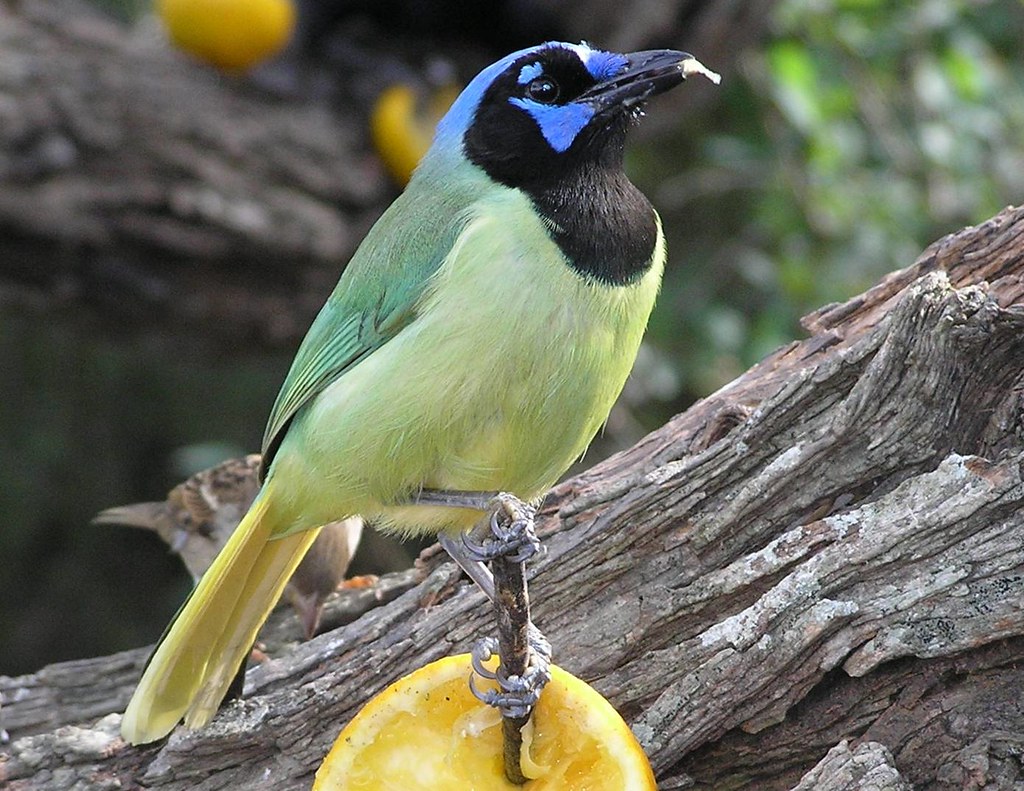
5. **Green Jay**For those with an appreciation for the exotic and vibrant, the Green Jay, *Cyanocorax yncas*, is an absolute highlight, presenting a spectacular mix of bright green, blue, and black plumage. This species boasts dark green backs and paler bellies, elegantly contrasted by bright blue and black heads, creating a truly unforgettable visual spectacle. Its striking coloration makes it a standout, akin to a rare gem discovered in the wild, instantly captivating any observer.
This colorful species is considered a rare find within the United States, primarily observed only in southern Texas, along the northern fringes of its extensive range. The Green Jay typically thrives along the coasts of Mexico, Central America, and South America, showcasing its preference for tropical and subtropical environments. Its appearance in Texas marks a significant ecological event, as its range has been expanding northward, with sightings now extending to Laredo, Corpus Christi, and even San Antonio, nearly 300 miles north. This expansion, a highlight of many birding hotspots, is notably linked to warming climates, leading to new and unexpected avian interactions.
One such remarkable interaction is the recent discovery of a hybrid bird, dubbed a “grue jay,” a cross between a green jay mother and a blue jay father. This phenomenon is a striking example of the rapid ecological changes influenced by human activity and climate shifts, bringing together species whose evolutionary paths diverged at least 7 million years ago. The existence of this hybrid underscores the fluid and unpredictable nature of ecosystems under pressure, prompting scientists to ponder the deeper implications of such rare pairings.
Green Jays can often be found in woodlands near streams and other water sources, where they forage on a diet of insects, fruits, and seeds. For enthusiastic birdwatchers in Texas, these beautiful birds are often spotted at feeders in state parks and refuges, where they show a particular fondness for oranges and grape jelly, alongside more conventional offerings like peanuts, sunflower seeds, and corn. Access to water is also a significant draw, making birdbaths and natural water features attractive additions to their habitat.
Their vocalizations are as diverse as their plumage, encompassing a variety of fast calls that range from ‘Kaw’-like sounds to buzzing, clicking, peeps, and even screams, reflecting their lively and communicative nature. Green Jay nests are characteristically simple twig constructions, carefully lined with moss, leaves, and grass, providing a subtle yet secure nursery. Intriguingly, even their eggs possess a greenish tint, harmonizing with the adult plumage. A truly remarkable fun fact about Green Jays is their capacity for tool use; they are one of the few bird species known to utilize sticks to pry up bark in their quest for hidden food, a clear indicator of their advanced problem-solving abilities and intelligence.
Read more about: Beyond the Backstage Bananas: Unpacking the 13 Wildest Rider Demands of Music Superstars
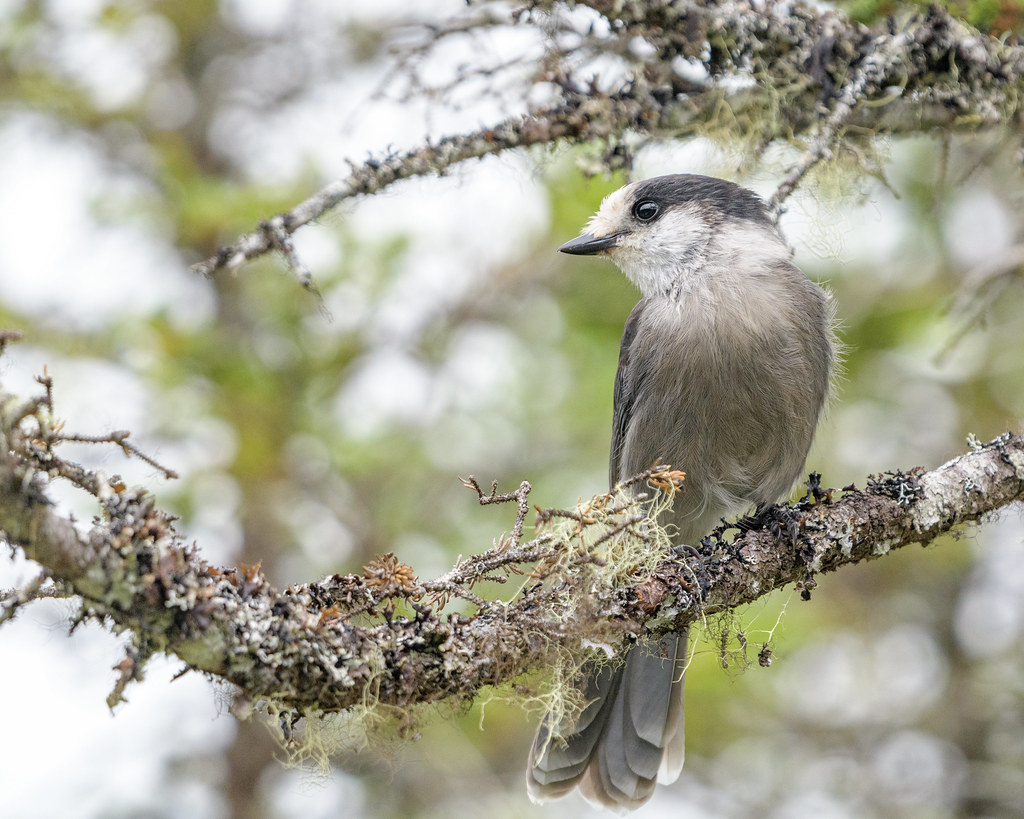
6. **Canada Jay**The Canada Jay, often affectionately known as the Grey Jay, *Perisoreus canadensis*, stands apart from its more boisterous relatives with an endearing tameness and undeniably cute demeanor. These jays exhibit a distinct visual profile: dark gray on the back, transitioning to a soft pale gray underneath, complemented by white heads and throats, and a subtle black band gracefully running around the back of the head. Females are visually identical to males, while juveniles present a slightly darker grayish-blue hue. Fluffy gray and white, with a small bill exquisitely suited for twisting off meat, they possess a charming appearance that belies their resourceful nature.
Canada Jays are steadfast residents of the far North, inhabiting boreal and coniferous forests across Canada, Alaska, and the high mountains of the northwest US. Interestingly, slight color variations can be observed, with those found in the Rockies often appearing paler than their Canadian counterparts. Their adaptation to cold, forested environments is a testament to their resilience and specialized ecological niche, making them a true high-altitude connoisseur of the avian world.
Renowned for their exceptional tameness, Canada Jays are famed for boldly approaching hikers, hunters, and campers, often eating directly from a human hand. Unlike many of their kin, these jays are opportunity feeders with a broad diet, consuming insects, berries, and even dead animals. They show a strong preference for meat, bread, suet, and other soft foods, which they meticulously cache in bark or branches rather than burying them in the soil. Nuts and seeds at feeders are considerably less appealing to them, highlighting a unique dietary specialization.
Despite their gentle appearance, Canada Jays possess a ‘deadly side’; they are known to prey on baby birds for food and even hunt smaller species such as chickadees and warblers. This behavior often causes alarm among other nesting birds when a Canada Jay is near, underscoring their predatory role within their ecosystem. These calm jays also tend to be more silent than their relatives, utilizing a gentle whispered song interspersed with harsher calls and clatters, and like other corvids, they can imitate other species’ sounds.
Their nesting habits are particularly notable for their timing and ingenuity. Canada Jays build their nests remarkably early in the season, often while snow still blankets the conifers. These nests, constructed from dead twigs and meticulously lined with feathers, are typically positioned on the south side of the tree for optimal warmth, a critical adaptation for early breeding in harsh climates. For those wishing to attract these charming yet cunning birds, most kinds of bird food, especially seeds and suet, offered in tube or platform feeders, will readily appeal to them. A fascinating ‘fun fact’ is their unique biological mechanism: Canada Jays produce a special saliva, which they use to mold food into a sticky blob, akin to gum, then expertly stick it into various hiding places, ensuring a reliable food supply for leaner times.
Our exploration continues into the further reaches of North America’s avian landscape, delving into the remaining six jay species that, much like an exclusive collection, each possess a distinctive narrative of elegance, resilience, and captivating behavior. These birds, often overlooked in the grand tapestry of wildlife, offer a profound glimpse into ecological ingenuity and evolutionary artistry, solidifying their status as true connoisseurs of their respective environments. Prepare to uncover the intricacies that make each of these corvids a remarkable exhibit in nature’s most sophisticated gallery.
Read more about: Beyond the Banquet: Unpacking the ‘Succession’ Cast’s Real Food & Style Habits, and the Roys’ Power Plays with Palates

7. **Pinyon Jay**The Pinyon Jay, *Gymnorhinus cyanocephalus*, presents a striking, uniform azure palette, distinguished by its shorter tail and the notable absence of a crest, setting it apart from its more flamboyant relatives. This species is characterized by its entirely blue plumage, with a slightly darker back contrasting a paler belly and a crisp white throat. Interestingly, unlike many other jays, the Pinyon Jay possesses a unique anatomical feature: its nostrils are free of feathers, a practical adaptation preventing the sticky pine pitch from adhering to them during their specialized foraging activities within pinyon-pine forests.
These fascinating jays are permanent residents in the inland western US states, exclusively preferring the distinctive pinyon-pine forests for their habitat. They are often observed roaming in sizable, vocal flocks, a collective approach that enhances their foraging efficiency and social cohesion. However, the Pinyon Jay’s story carries a poignant note, as this western species faces a dramatic decline, with an estimated 85% reduction in population since 1970, largely due to the conversion of their essential tree and shrubby habitats into grazing lands.
Their dietary preferences are deeply intertwined with their specialized habitat, primarily focusing on the rich, meaty pinyon pine nuts. Beyond this staple, their discerning palate extends to juniper berries, various acorns, and a protein-rich selection of small animals, including lizards, baby birds, and a diverse array of insects. As opportunistic feeders, they readily adapt to available resources, foraging in large, bustling groups to secure sustenance.
For those fortunate enough to observe them, their vocalizations are quite distinct, characterized by three close ‘kaw’-like calls that rise and then fall, sometimes carrying a shaking or trembling quality. Nests, robust constructions of sticks and grass, are meticulously built within pine trees and luxuriously lined with feathers and animal hair, providing a warm, secure sanctuary for their offspring. Attracting these declining beauties can be achieved by offering traditional jay fare like sunflower seeds, peanuts, corn, and suet, serving as a testament to their enduring appeal even amidst environmental challenges.
Read more about: North America’s Feathered Dynasts: Exploring the Intelligence, Diversity, and Unseen Hybrids of the Jay Family

8. **Florida Scrub-Jay**An exclusive resident of the Sunshine State, the Florida Scrub-Jay, *Aphelocoma coerulescens*, offers a distinctive profile within the jay family, immediately recognizable by its harmonious blend of blue and gray. These elegant birds display a consistent blue on their bodies, complemented by gray bellies, backs, and foreheads, all culminating in a long, expressive blue tail. Notably, they are crestless, presenting a sleeker silhouette, and while males and females share this identical sophisticated appearance, juveniles are characterized by a slightly grayer plumage and head, hinting at their eventual vibrant coloring.
As their name proudly proclaims, Florida Scrub-Jays are endemic to Florida, meaning they are native and exclusively found within its unique scrub environments, never migrating beyond its sandy borders. They thrive in relatively open scrubby areas dominated by oak scrub, where they can be observed meticulously foraging on the ground for insects, berries, and, crucially, acorns. This very specificity, however, makes them particularly vulnerable, as housing development has severely impacted their homelands, carving their essential scrub oak habitats into ever-smaller fragments.
Acorns form the cornerstone of the Florida Scrub-Jay’s diet, demonstrating an impressive level of foresight and resource management; a single bird is known to cache an astonishing 6,000 or more acorns each year for leaner times. Beyond their favored acorns, they also consume insects and berries, adapting their diet seasonally. For those eager to contribute to their sustenance, feeders stocked with peanuts prove highly effective in supporting these vulnerable populations.
Their communication is an integral part of their social structure, characterized by quite harsh, repetitive calls, signaling their highly interactive and vocal nature as they constantly call to each other. Their nesting habits are equally compelling, typically occurring in oak trees or shrubs where they form cooperative flocks. These social units, often including young from the previous year, work together to protect against predators and share feeding duties for the growing family. This communal effort ensures the survival of their offspring until they establish their own territories, a profound example of cooperative breeding within the avian world.
Read more about: From Brilliant Blues to Stealthy Greys: Uncovering the Enduring Legacy of the Jay Family Across North America and Beyond

9. **Black-throated Magpie-Jay**Emerging from the vibrant tropical landscapes, the Black-throated Magpie-Jay, *Calocitta colliei*, makes a truly arresting visual statement, a grand avian spectacle combining length, elegance, and dramatic contrasts. This large, long-tailed bird is instantly distinguishable by its conspicuous black crest and a matching black throat, which serves as a bold counterpoint to a patch of brilliant blue on its eyebrows and beneath the eye. Its striking blue wings, a pristine white-tipped tail, and a pure white underside complete a sophisticated plumage. Intriguingly, individuals found in the southern parts of their range exhibit a subtly thinner black band on their throats, accompanied by more expansive white markings, presenting a refined regional variation.
These magnificent jays prefer to grace tropical lowland forests with their presence, extending their domain into cultivated plantations and partially open areas adorned with tall trees and protective hedges. While adaptable to certain human-modified environments, they maintain a discerning preference, generally avoiding overly humid woodlands, showcasing a clear taste for drier, more open arboreal settings. Their habitat choices underscore a refined balance between natural forest and accessible, managed lands.
True to their crow family lineage, the Black-throated Magpie-Jay adheres to an omnivorous diet, meticulously balancing both plant and animal matter. Their culinary leanings include a strong appreciation for seeds and nuts, which they forage with considerable acumen. However, their resourceful nature also extends to consuming a variety of insects and even preying on smaller birds, illustrating their crucial role as opportunistic predators within their ecosystem, a testament to their intelligence and adaptability in securing sustenance.
Their nests are typically sturdy yet elegantly constructed, comprising an intricate framework of sticks and twigs, meticulously lined with softer materials to ensure comfort and warmth for their clutch. These carefully crafted nurseries are designed to house up to seven eggs, reflecting a significant reproductive investment. A truly distinctive behavioral trait, almost an act of avian ceremony, is their unique feeding posture: the Black-throated Magpie-Jay invariably eats standing up, expertly using one foot to secure its food while the other gracefully delivers it to its mouth, a captivating display of avian dexterity and poise.
Read more about: From Brilliant Blues to Stealthy Greys: Uncovering the Enduring Legacy of the Jay Family Across North America and Beyond
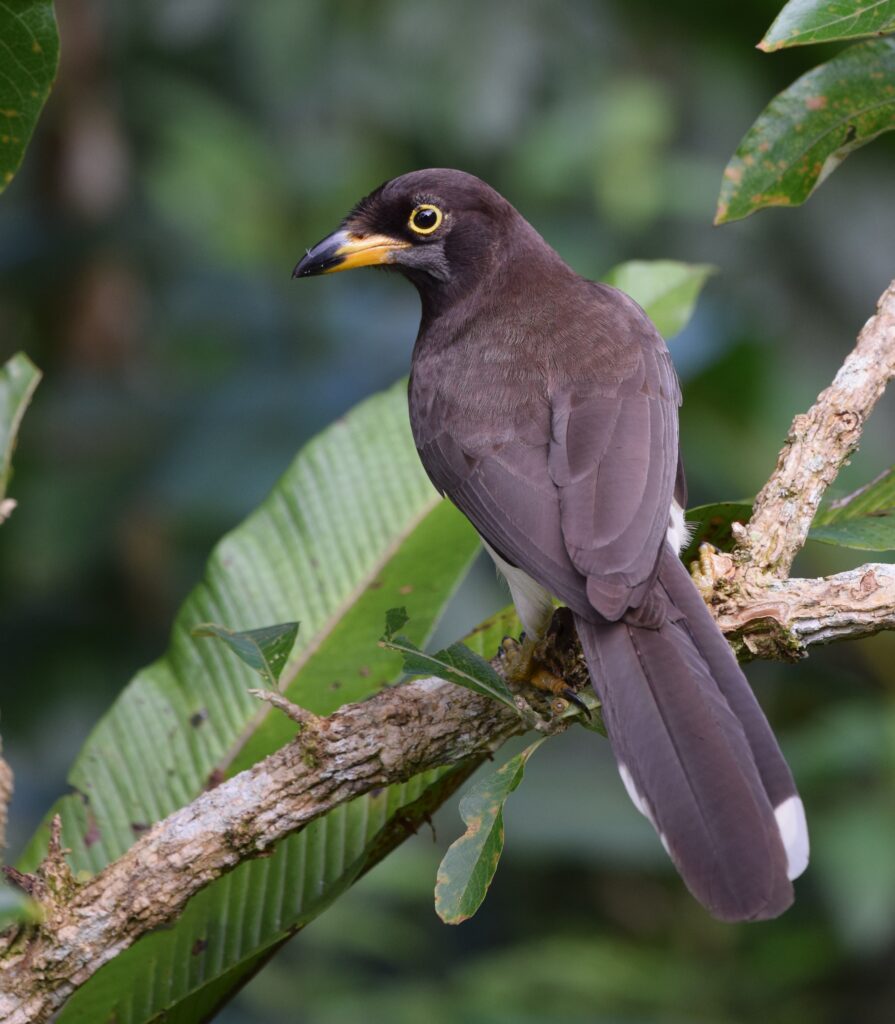
10. **Brown Jay**The Brown Jay, *Psilorhinus morio*, stands as a monumental presence among its North American kin, a testament to understated grandeur and imposing stature. This large bird often presents as uniformly dark brown, with a subtle lighter tint across its back, lending it a profound, earthy elegance. In a captivating regional variation, some southern populations feature contrasting white bellies and delicate white tips on their tail feathers, adding a touch of visual intrigue. A striking developmental detail distinguishes them: adults boast sleek black bills, legs, and feet, while the young parade with vibrant yellow legs and distinctive yellow eye-rings, a momentary splash of color in their early lives.
Primarily recognized as inhabitants of Mexico and Central America, the Brown Jay also extends its stately presence northward, gracing the southernmost reaches of Texas. Within these varied locales, they maintain a clear preference for dense woodlands adorned with tall, mature trees, always ensuring a close proximity to vital water sources. This habitat selection underscores their reliance on rich, established ecosystems and the consistent availability of hydration, reflecting a sophisticated understanding of their environmental needs.
As dedicated omnivores, their diet is remarkably extensive and adaptable, a true gourmand’s selection of natural provisions. They expertly forage for insects and small rodents, demonstrating a predatory efficiency. This is elegantly balanced with a diverse menu of berries, ripe fruits, various seeds, and even nectar, collected as they hop gracefully from branch to branch or explore the forest floor. Their comprehensive foraging strategy highlights their intelligence and flexibility in utilizing a wide array of food sources.
Nesting within the Brown Jay community is a profoundly cooperative affair, reflecting an advanced social structure. Flocks share communal nests, typically situated within the sturdy fork of a tree branch or a discreet low-lying shrub. Several adults contribute to the meticulous construction of these cup-shaped nests, skillfully weaving together sticks and twigs, then lining them with soft weeds and other delicate materials to create a comfortable cradle for their young. They lay up to eight eggs, which typically hatch after around twenty days. The young, a future generation of these grand birds, fledge and leave the nest in about four weeks, a testament to the collective efforts of the entire flock.
Read more about: Unlocking the Vault: A Deep Dive into Ralph Lauren’s Multi-Million Dollar Ferrari Collection and Beyond

11. **Mexican Scrub-Jay**The Mexican Scrub-Jay, *Aphelocoma wollweberi*, embodies a sophisticated subtlety, presenting a medium-sized profile adorned in delicate pale bluish-gray tones. This species is notably lighter in color compared to many of its jay relatives, with a gracefully grayish upper neckline and chest that lends it an air of understated elegance. Its ensemble is completed by a small, precisely formed black bill, a refined detail that contributes to its distinct and less assertive appearance. The Mexican Scrub-Jay is a true connoisseur of high-altitude woodlands, found primarily in open oak and pine forests, where the canopy provides both shelter and an abundance of resources.
Their diet reflects a deeply intuitive understanding of seasonal cycles, a strategic approach to sustenance. During the warmer months, their primary focus is on a protein-rich bounty of insects, small reptiles, and, resourcefully, the eggs and young of other birds, showcasing their role as adept foragers within their ecosystem. As winter descends, their culinary preferences shift to the essential, relying heavily on acorns and pine nuts meticulously stored during the preceding seasons. This foresight in caching exemplifies their remarkable intelligence and planning.
Nesting duties within the Mexican Scrub-Jay community are a shared endeavor, with both males and females collaborating to construct their nests high in trees, strategically shielded by thick foliage for ultimate protection. These robust structures are meticulously crafted from sticks and twigs, then lined with delicate rootlets and plant materials, ensuring a soft and secure environment for their offspring. They typically lay around five eggs, which hatch after approximately eighteen days. The young fledge and depart the nest after about twenty-five days, yet they continue to benefit from the watchful care of the flock for several more weeks, a testament to their strong communal bonds.
Adding a layer of intrigue to their behavioral repertoire, the Mexican Scrub-Jay has an unusual symbiotic relationship with Northern Flickers. These woodpeckers are known to follow Mexican Jays in flight, particularly during migration, utilizing the jays’ loud, shrill voices as an early warning system against potential predators. This fascinating interspecies dynamic underscores the Mexican Scrub-Jay’s significant, though perhaps unwitting, ecological role as a sentinel of the skies.
Read more about: From Brilliant Blues to Stealthy Greys: Uncovering the Enduring Legacy of the Jay Family Across North America and Beyond
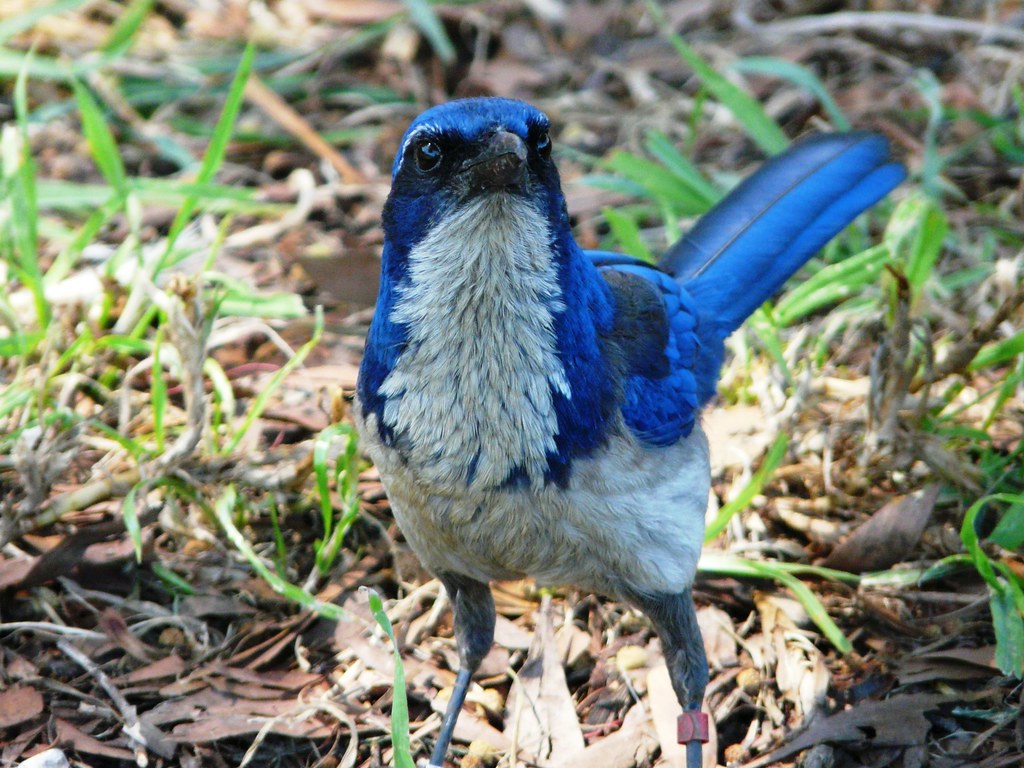
12. **Island Scrub Jay**For the ultimate in avian exclusivity, we turn our attention to the Island Scrub-Jay, *Aphelocoma insularis*, a truly bespoke specimen of North American avifauna. These large, brightly-colored birds bear a striking resemblance to the California Scrub-Jay, yet they elevate this aesthetic with feathers that are distinctly darker and more richly-hued, embodying a premium, bespoke quality. Their plumage is a luxurious blue from head to tail across their back, complemented by sophisticated gray tones on top of their wings, all elegantly framed by pristine white throats.
What truly sets the Island Scrub-Jay apart, however, is its unparalleled geographic specificity: it is a permanent resident, and indeed, endemic, to Santa Cruz Island, off the coast of California. It famously never migrates, boasting the smallest range of any North American bird. This island sanctuary, dominated by ancient oak woodlands and chaparral, interspersed with streamside thickets and other indigenous trees, provides a perfectly curated environment for this exclusive species. Their confined habitat makes them a jewel of biodiversity, a unique expression of island evolution.
Their diet is a robust and varied selection, reflecting the island’s rich ecosystem. Primarily, they feast on a bounty of insects, small lizards, and mice, showcasing their predatory prowess. Resourcefully, they also target the eggs and young of other smaller birds. As fall descends, their culinary focus shifts to the abundant acorns, which they deftly crack open with their strong beaks. This dietary flexibility ensures their survival within their limited yet resource-rich environment.
Nests of the Island Scrub-Jay are ingeniously hidden within the protective embrace of oak trees. These are sturdy constructions, skillfully built with twigs and then meticulously lined with fine rootlets and soft animal hair, creating a luxurious and secure interior. They typically lay around four eggs, which incubate for approximately eighteen days before hatching. While the precise details of when the young birds leave the nest remain a subject of ongoing observation, the craftsmanship and careful placement of their nests highlight the species’ dedication to nurturing its next generation within its unique island domain.
Read more about: From Brilliant Blues to Stealthy Greys: Uncovering the Enduring Legacy of the Jay Family Across North America and Beyond
Our curated journey through the diverse world of North American jays reveals a collection of intelligence, adaptability, and breathtaking beauty. From the cooperative Florida Scrub-Jays to the hyper-exclusive Island Scrub-Jay, each species is a testament to nature’s remarkable artistry and evolutionary genius. These aren’t merely birds; they are living testaments to ecological intricacy, each a distinctive gem in the continent’s avian crown, reminding us of the profound grandeur residing in our natural world.



